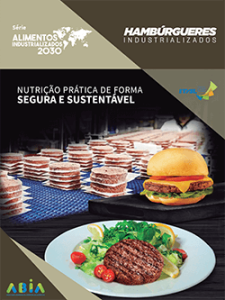NUTRITIONAL VALUE OF INDUSTRIALIZED HAMBURGERS
The analysis of the sample of 90 products revealed that the hamburgers contribute with significant quantities of PROTEINS for their consumptions feeding and nutrition. Based on the Anvisa Normative Instruction IN no. 75, from October 8th, 2020, products made with meat (beef, chicken, pork) contain more than 20% of the daily recommendation of 50 g of protein, per portion of 80 g. Among those made with vegetables (soybean, pea, chicken pea, lentil, etc.), 80.6% contain more than 10% of the VDR and 44.4% more than 20% of the VDR of proteins (portion of 80 g). It should be noted that this analysis does not consider the differences in the quality of the proteins contained in the hamburgers, that is, their ability to fulfill human nutritional requirements for essential and non-essential amino acids. A good quality or high biological value protein mixture is the one that provides good digestibility, adequate amounts of essential amino acids and total nitrogen.
Generally, meats are included as food rich in protein and provide between 15% and 20% of protein, which is considered as a very good quality, as it supply all the necessary essential amino acids, in addition of being the best source of iron and e vitamin B12. And the plant-based hamburgers, according to their quite variable formulation, can present deficiencies in basic amino acids, which is characteristic of proteins found in vegetables. For example, vegetables usually have a high protein content, from 17% to 25%, a proportion similar to cereals and even higher than that of meat and fish, but of lower biological value. On the other hand, despite the differences between cultivars, soybean contains a high percentage of high-quality proteins, with almost 37 g per 100 g, in addition of having most of the essential amino acids, with the exception of methionine, which can be compensated by combining it with other types of food, such as cereals.
PROTEINS
In average, in portions of 80 g, MEAT products have 14.7 g of PROTEIN (29.3% of VDR); the product with the highest content has 23.0 g (46.0% of VDR) and the product with the lowest content has 11.4 g (22.9% of VDR). It was observed that, according to the Anvisa Normative Instruction IN no. 20, from July 31st, 2000, Annex IV of Technical Regulation for Hamburger Identity and Quality, is a requirement for industrialized hamburgers contain to contain at least 15% of proteins (15 g per 100 g or 12 g per 80 g);
DIETARY FIBERS
The sample analysis of 90 products revealed that, only vegan hamburgers present significant quantities of FIBERS due to the nature of their ingredients. Based on the Anvisa Normative Instruction IN no. 75, from October 8th, 2020, 27 plant-based products can be classified as SOURCE of fibers, per portion of 80 g. Some meat products present relevant quantities of fibers, depending on the ingredients used.
IRON
In the total of the sample analyzes, a small quantity of hamburgers (6 products) have a voluntary statement of IRON in the nutritional label. Among them, there is a beef hamburger and a chicken hamburger that can be considered as a SOURCE of Iron, per portion of 80 g, based on the Anvisa Normative Instruction IN no. 75, from October 8th, 2020.
CALORIES (ENERGY VALUE)
Generally, hamburgers are not products of low ENERGY VALUE due to the nature of its ingredient. However, the quantities of calories vary significantly among the analyzed products. As observed in the chapter about trends, products have been developed with reduced energy value, with ingredients reformulation and fats reduction. Meat and vegetable products have similar content of calories.
CARBOHYDRATES
The quantities of CARBOHYDRATES in hamburgers vary significantly according to the ingredients present in their formulation, both for meat products and among vegetables. Generally, animal protein hamburgers have low quantities of carbohydrates, with 42.6% of these products having 0 g per portion of 80 g.
SATURATED FAT
The quantities of SATURATED FAT in hamburgers vary significantly according to the ingredients present in their formulation. Generally, due to the natural raw materials composition, meat products have higher quantities in comparison with vegetables.
It is important to note that fat, as well as carbohydrates, as it is a source of energy, it provides essential fatty acids, necessary for the development, and it makes the absorption of fat-soluble vitamins (A, D, E and K) easier by intestine. In addition, it play an important function of energy ans structural power. On the other hand, the excessive consumption of saturated fat is associated to the increase of bad cholesterol or LDL levels, which can be adhered to the artery and lead to cardiovascular diseases, such as heart attack and HVAC (stroke). For that reason, World Health Organisation (WHO) establishes limits for its consumption. The ideal is the intake of saturated fat not higher than 10% of calories ingested on a day, equivalent to about 21 g. For those who are subject to a cardiac risk, the suggested value is 7%, or about 15 g.
TRANS FAT
The quantities of TRANS FAT in hamburgers vary significantly according to the ingredients present in their formulation, being present in only a smaller portion (28%) of meat products of the analyzed sample.
Trans fats are naturally present in small quantities in meat and ruminant animals mil, such as cow and sheep. It happens because certain bacteria present in the rumen of these animals promote the bio-hydrogenation fatty acids these animals intake. In addition to meat, there are products that use plant-based fat and oils (in the sample, 25 products use plant-based oils and fats and 1 margarine) in the hamburgers preparation, which also contributes to add a trans fat content above 0.2 g. That is because trans fat can be generated in some industrial processes, mainly in partial hydrogenation of plant-based or animal-based oils. That is because trans fat can be generated in some industrial processes, mainly in partial hydrogenation of plant-based or animal-based oils.
SODIUM
The quantities of SODIUM in hamburgers vary significantly according to the ingredients present in their formulation, being present in only a smaller portion (28%) of meat products of the analyzed sample.The quantity of SODIUM in hamburgers varies significantly according to the ingredients present in its formulation.
In average, in portions of 80 g, MEAT products have 361 mg of SODIUM (18.0% of VDR); the product with the highest content has 16 mg (55.3% of VDR) and the product with the lowest content has 40 mg (2.0% of VDR);
In average, in portions of 80 g, VEGETABLE products have 372 mg of SODIUM (18.6% of VDR); the product with the highest content has 776 mg (38.8% of VDR) and the product with the lowest content has 123 mg ((6.1% do VDR).




